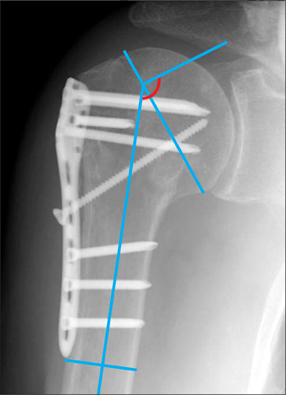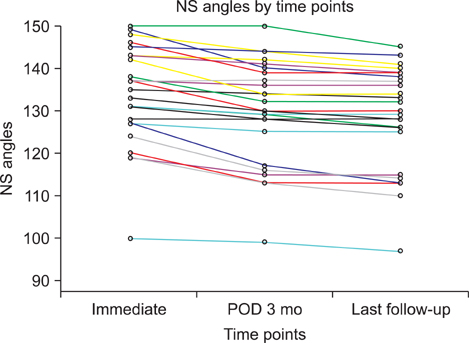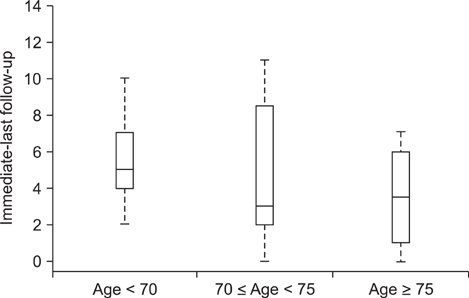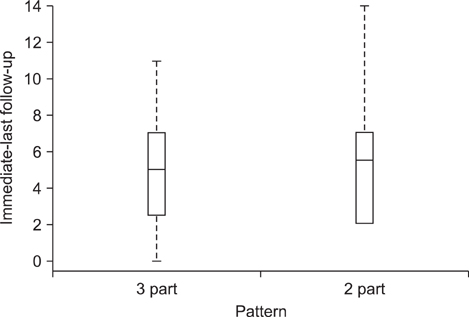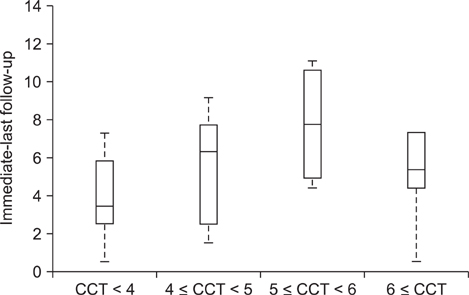Clin Orthop Surg.
2012 Sep;4(3):209-215. 10.4055/cios.2012.4.3.209.
Locking Plate for Proximal Humeral Fracture in the Elderly Population: Serial Change of Neck Shaft Angle
- Affiliations
-
- 1Department of Orthopedic Surgery, Asan Medical Center, University of Ulsan College of Medicine, Seoul, Korea. jeonchoi@gmail.com
- KMID: 1392983
- DOI: http://doi.org/10.4055/cios.2012.4.3.209
Abstract
- BACKGROUND
We conducted this radiographic study in the elderly population with proximal humeral fracture aiming to evaluate 1) the serial changes of neck-shaft angle after locking plate fixation and 2) find relationship between change in neck shaft angle and various factors such as age, fracture pattern, severity of osteoporosis, medial support and initial reduction angle.
METHODS
Twenty-five patients who underwent surgical treatment for proximal humeral fracture with locking plate between September 2008 and August 2010 are included. True anteroposterior and axillary lateral radiographs were made postoperatively and at each follow-up visit. Measurement of neck shaft angle was done at immediate postoperative, 3 months postoperative and a final follow-up (average, 11 months; range, 8 to 17 months). Severity of osteoporosis was assessed using cortical thickness suggested by Tingart et al.
RESULTS
The mean neck shaft angles were 133.6degrees (range, 100degrees to 116degrees) at immediate postoperative, 129.8degrees (range, 99degrees to 150degrees) at 3 months postoperative and 128.4degrees (range, 97degrees to 145degrees) at final follow-up. The mean loss in the neck-shaft angle in the first 3 months was 3.8degrees as compared to 1.3degrees in the period between 3 months and final follow-up. This was statistically significant (p = 0.002), indicating that most of the fall in neck shaft angle occurs in the first three months after surgery. Relationship between neck shaft angle change and age (p = 0.29), fracture pattern (p = 0.41), cortical thickness (p = 0.21), medial support (p = 0.63) and initial reduction accuracy (p = 0.65) are not statistically significant.
CONCLUSIONS
The proximal humerus locking plate maintains reliable radiographic results even in the elderly population with proximal humerus fracture.
MeSH Terms
Figure
Reference
-
1. Helmy N, Hintermann B. New trends in the treatment of proximal humerus fractures. Clin Orthop Relat Res. 2006. 442:100–108.
Article2. Charalambous CP, Siddique I, Valluripalli K, et al. Proximal humeral internal locking system (PHILOS) for the treatment of proximal humeral fractures. Arch Orthop Trauma Surg. 2007. 127(3):205–210.
Article3. Wijgman AJ, Roolker W, Patt TW, Raaymakers EL, Marti RK. Open reduction and internal fixation of three and four-part fractures of the proximal part of the humerus. J Bone Joint Surg Am. 2002. 84(11):1919–1925.4. Mittlmeier TW, Stedtfeld HW, Ewert A, Beck M, Frosch B, Gradl G. Stabilization of proximal humeral fractures with an angular and sliding stable antegrade locking nail (Targon PH). J Bone Joint Surg Am. 2003. 85:Suppl 4. 136–146.5. Bastian JD, Hertel R. Osteosynthesis and hemiarthroplasty of fractures of the proximal humerus: outcomes in a consecutive case series. J Shoulder Elbow Surg. 2009. 18(2):216–219.
Article6. Wagner M. General principles for the clinical use of the LCP. Injury. 2003. 34:Suppl 2. B31–B42.
Article7. Fankhauser F, Boldin C, Schippinger G, Haunschmid C, Szyszkowitz R. A new locking plate for unstable fractures of the proximal humerus. Clin Orthop Relat Res. 2005. (430):176–181.
Article8. Bjorkenheim JM, Pajarinen J, Savolainen V. Internal fixation of proximal humeral fractures with a locking compression plate: a retrospective evaluation of 72 patients followed for a minimum of 1 year. Acta Orthop Scand. 2004. 75(6):741–745.
Article9. Agudelo J, Schurmann M, Stahel P, et al. Analysis of efficacy and failure in proximal humerus fractures treated with locking plates. J Orthop Trauma. 2007. 21(10):676–681.
Article10. Neer CS 2nd. Displaced proximal humeral fractures. I. Classification and evaluation. J Bone Joint Surg Am. 1970. 52(6):1077–1089.
Article11. Tingart MJ, Apreleva M, von Stechow D, Zurakowski D, Warner JJ. The cortical thickness of the proximal humeral diaphysis predicts bone mineral density of the proximal humerus. J Bone Joint Surg Br. 2003. 85(4):611–617.
Article12. Gardner MJ, Weil Y, Barker JU, Kelly BT, Helfet DL, Lorich DG. The importance of medial support in locked plating of proximal humerus fractures. J Orthop Trauma. 2007. 21(3):185–191.
Article13. Pinheiro J, Bates D. Mixed-effects models in S and S-plus. 2000. New York: Springer.14. Kristiansen B, Barfod G, Bredesen J, et al. Epidemiology of proximal humeral fractures. Acta Orthop Scand. 1987. 58(1):75–77.15. Hintermann B, Trouillier HH, Schafer D. Rigid internal fixation of fractures of the proximal humerus in older patients. J Bone Joint Surg Br. 2000. 82(8):1107–1112.
Article16. Meier RA, Messmer P, Regazzoni P, Rothfischer W, Gross T. Unexpected high complication rate following internal fixation of unstable proximal humerus fractures with an angled blade plate. J Orthop Trauma. 2006. 20(4):253–260.
Article17. Rowles DJ, McGrory JE. Percutaneous pinning of the proximal part of the humerus: an anatomic study. J Bone Joint Surg Am. 2001. 83(11):1695–1699.
Article18. Rajasekhar C, Ray PS, Bhamra MS. Fixation of proximal humeral fractures with the Polarus nail. J Shoulder Elbow Surg. 2001. 10(1):7–10.
Article19. Bernard J, Charalambides C, Aderinto J, Mok D. Early failure of intramedullary nailing for proximal humeral fractures. Injury. 2000. 31(10):789–792.
Article20. Leonard M, Mokotedi L, Alao U, Glynn A, Dolan M, Fleming P. The use of locking plates in proximal humeral fractures: comparison of outcome by patient age and fracture pattern. Int J Shoulder Surg. 2009. 3(4):85–89.
Article21. Badman BL, Mighell M. Fixed-angle locked plating of two-, three-, and four-part proximal humerus fractures. J Am Acad Orthop Surg. 2008. 16(5):294–302.
Article22. Koukakis A, Apostolou CD, Taneja T, Korres DS, Amini A. Fixation of proximal humerus fractures using the PHILOS plate: early experience. Clin Orthop Relat Res. 2006. 442:115–120.
Article23. Leyshon RL. Closed treatment of fractures of the proximal humerus. Acta Orthop Scand. 1984. 55(1):48–51.
Article24. Zhang L, Zheng J, Wang W, et al. The clinical benefit of medial support screws in locking plating of proximal humerus fractures: a prospective randomized study. Int Orthop. 2011. 35(11):1655–1661.
Article25. Moonot P, Ashwood N, Hamlet M. Early results for treatment of three- and four-part fractures of the proximal humerus using the PHILOS plate system. J Bone Joint Surg Br. 2007. 89(9):1206–1209.
Article26. Siwach R, Singh R, Rohilla RK, Kadian VS, Sangwan SS, Dhanda M. Internal fixation of proximal humeral fractures with locking proximal humeral plate (LPHP) in elderly patients with osteoporosis. J Orthop Traumatol. 2008. 9(3):149–153.
Article27. Wallace MJ, Bledsoe G, Moed BR, Israel HA, Kaar SG. Relationship of cortical thickness of the proximal humerus and pullout strength of a locked plate and screw construct. J Orthop Trauma. 2012. 26(4):222–225.
Article28. Hepp P, Lill H, Bail H, et al. Where should implants be anchored in the humeral head? Clin Orthop Relat Res. 2003. (415):139–147.
Article29. Liew AS, Johnson JA, Patterson SD, King GJ, Chess DG. Effect of screw placement on fixation in the humeral head. J Shoulder Elbow Surg. 2000. 9(5):423–426.
Article30. Yang H, Li Z, Zhou F, Wang D, Zhong B. A prospective clinical study of proximal humerus fractures treated with a locking proximal humerus plate. J Orthop Trauma. 2011. 25(1):11–17.
Article
- Full Text Links
- Actions
-
Cited
- CITED
-
- Close
- Share
- Similar articles
-
- Comparison of Radiologic and Clinical Results between Locking Compression Plate and Unlocked Plate in Proximal Humerus Fractures
- Internal Fixation of Proximal Humerus Fracture with Locking Compression Plate
- Polarus Intramedullary Nail for Proximal Humeral and Humeral Shaft Fractures in Elderly Patients with Osteoporosis
- Efficacy of Additive Trans-cuff Augmentation Sutures for Proximal Humeral Fractures Stabilized by Locking Plates in Elderly Patients
- Minimally Invasive Plate Osteosynthesis for Humeral Proximal or Distal Shaft Fractures Using a 3.5/5.0 Metaphyseal Locking Plate

